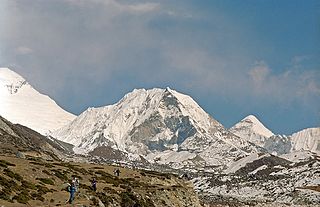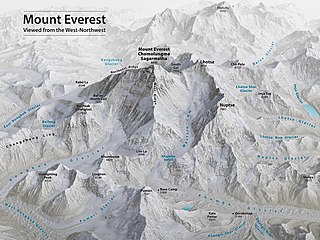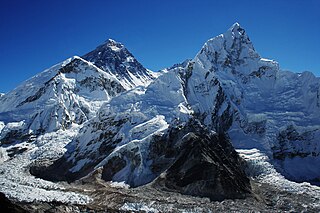
Lhotse is the fourth highest mountain in the world at 8,516 metres (27,940 ft), after Mount Everest, K2, and Kangchenjunga. Part of the Everest massif, Lhotse is connected to the latter peak via the South Col. Lhotse means "South Peak" in Tibetan. In addition to the main summit at 8,516 metres (27,940 ft) above sea level, the mountain comprises the smaller peaks Lhotse Middle (East) at 8,414 m (27,605 ft), and Lhotse Shar at 8,383 m (27,503 ft). The summit is on the border between Tibet of China and the Khumbu region of Nepal.

Nuptse or Nubtse is a mountain in the Khumbu region of the Mahalangur Himal, in the Nepalese Himalayas. It lies two kilometres WSW of Mount Everest. Nubtse is Tibetan for "west peak", as it is the western segment of the Lhotse-Nubtse massif.

Imja Tse, better known as Island Peak, is a mountain in Sagarmatha National Park of the Himalayas of eastern Nepal. The peak was named Island Peak in 1953 by members of the British Mount Everest expedition because it appears as an island in a sea of ice when viewed from Dingboche. The peak was later renamed in 1983 to Imja Tse but Island Peak remains the popular choice. The peak is actually an extension of the ridge coming down off the south end of Lhotse Shar.

Mount Everest is the world's highest mountain, with a peak at 8,848 metres (29,029 ft) above sea level. It is situated in the Himalayan range of Solukhumbu district, Nepal.

Ernst Reiss was a Swiss mountaineer, who together with Fritz Luchsinger was the first to climb the fourth highest mountain on earth in 1956.

Zygmunt Andrzej Heinrich was a Polish mountaineer. He died in an avalanche on the northwest slopes of Mount Everest in 1989.
Adrian Ballinger is a British-American certified IFMGA/AMGA mountain guide, certified through the American Mountain Guides Association. Ballinger has been guiding full-time for 15 years, and has led over 100 international climbing expeditions on five continents. Ballinger, along with Himalayan Experience's founder, Russell Brice, has been featured on the Discovery Channel's Everest: Beyond the Limit series. Ballinger worked for Himex until 2012. Ballinger founded Alpenglow Expeditions and has worked as a guide for it. Adrian is noted for pioneering the use of pre-acclimation for commercial expeditions as early as 2014, which can cut the amount of on-site time in half compared to a typical Everest summit bid expedition. He has also gone on climbs sponsored by the Eddie Bauer company. In 2016 and 2017 he went on Everest expeditions with Cory Richards, and in 2017 Adrian reached the summit from the Tibet/China/North route without using bottled oxygen.

Led by Edouard Wyss-Dunant, the 1952 Swiss Mount Everest expedition saw Raymond Lambert and Sherpa Tenzing Norgay reach a height of about 8,595 metres (28,199 ft) on the southeast ridge, setting a new climbing altitude record, opening up a new route to Mount Everest and paving the way for further successes by other expeditions.

The Geneva Spur, named Eperon des Genevois and has also been called the Saddle Rib is a geological feature on Mount Everest—it is a large rock buttress near the summits of Everest and Lhotse. The Geneva spur is above Camp III and the Yellow Band, but before Camp IV and South Col. It is a spur near the south col. A related formation is the saddle (landform) between the peaks of Mount Everest and Lhotse.

Jürg Marmet was a Swiss mountaineer. Marmet was part of the first two-man Swiss team which climbed Mount Everest in 1956.. Marmet and his climbing partner, Ernst Schmied, became the third and fourth people to reach Mount Everest's summit on May 23, 1956. He was also one of the first Swiss citizens to climb to the top of Mount Everest. Marmet and Schmied narrowly beat the next Swiss team to the top: The next day, the next two-man Swiss expedition of Hansruedi von Gunten and Dölf Reist reached the top of the mountain on May 24, 1956. Marmet and Schmied were also the first Swiss to ascend Lhotse in 1956.

Matt Moniz is an American mountaineer and speaker noted for his ascents of 8,000 meter peaks and several of the Seven Summits.

Asian Trekking is a commercial adventure company based out of Kathmandu, Nepal started by Sherpa Ang Tshering. In 2001, it was recorded that Asian Trekking ran 25 large mountain expeditions per year. Asian Trekking made international news when in 2006 four of its clients and two of its Sherpas died in a single season. One of their clients, David Sharp, died near the summit and this event became the center of an international climbing ethics controversy. Founder of the company Ang said that climbers can die if they use all their energy getting to the summit of Mount Everest, only to be too fatigued for the descent.
Pasang Dawa Lama was a Sherpa Nepalese mountaineer, sirdar. Pasang is considered to be one of the greatest Sherpa mountaineers of the 20th century.
Ernst Schmied was a Swiss Mountaineer. He is best known for achieving the second successful summit of Mount Everest, on 23 May 1956, as part of the 1956 Swiss Expedition to Everest and Lhotse.
Hansruedi von Gunten is a Swiss chemist and mountaineer. Together with Dolf Reist he succeeded on May 24, 1956, the third ascent of Mount Everest.











